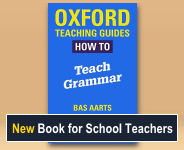Form and function
A useful distinction in grammar is that of grammatical form and grammatical function. Grammatical form is concerned with the description of linguistic units in terms of what they are, and grammatical function is concerned with the description of what these linguistic units do. Note that we use capital letters at the beginning of function labels, but this is by no means standard practice everywhere.
Goal
Understanding the way that form and function relate to one another has important implications for text production and comprehension, and enables students to more accurately discuss how grammatical structure relates to meaning.
Here are the linguistic units relevant to the levels of form and function in a table. Hover over the labels with your cursor and click to see the full Glossary definition.
|
The terms Predicator and Modifier are not statutory in the National Curriculum, nor are the labels adjective phrase and adverb phrase. It may be useful to revisit the relevant pages on word classes, phrases, clauses and function labels if you need to.
Let's see how form-function operates in language. Consider the following sentence:
- The plumber fixed the tap.
In this sentence the plumber is doing the fixing, and this phrase therefore functions as the grammatical Subject; whereas the tap is being fixed, which means that this noun phrase functions as the grammatical Object.
We can use a table to show the form/function interface more clearly:
|
||||||||||||||||||||||||||||
It's important to be aware of the fact that the functional 'slots' of Subject, Object and Adverbial can typically be 'filled' by various different grammatical forms, as indicated in the table:
| Grammatical function | Grammatical form | Example |
| Subject | noun | Sylvia loves doughnuts. |
| pronoun | She is tired. | |
| noun phrase | The washing machine is broken. | |
| Object | noun | Eva loves linguistics. |
| pronoun | I want it. | |
| noun phrase | She smashed my new phone. | |
| Adverbial | adverb | Suddenly, the elephants continued on their way. |
| adverb phrase | Very suddenly, the elephants continued on their way. | |
| preposition phrase | In the morning, the elephants continued on their way. | |
| noun phrase | The next day, the elephants continued on their way. | |
| subordinate clause | When they had eaten, the elephants continued on their way. |
You may think of other forms that can function as Subject and Object.
If you want to read more about form and function, have a look at these pages on Bas Aarts' blog:
In the activity, students are asked to work out the form and function labels of a list of given sentences.
Welcome!

Englicious is totally free for everyone to use!
But in exchange, we ask that you register for an account on our site.
If you’ve already registered, you can log in straight away.
Since this is your first visit today, you can see this page by clicking the button below.
- Printer-friendly version
- Log in to view or leave comments

